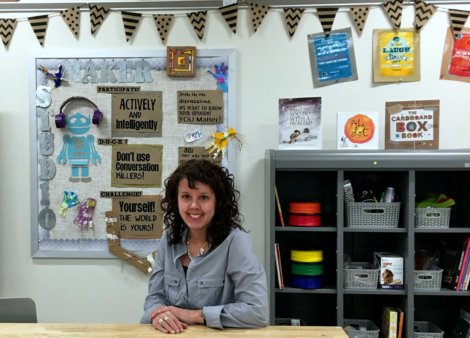
Supporting ELLs with CBE of the Month Bryan Betz
Posted by cemignano on
We’d like to welcome February’s Certified BrainPOP Educator of the Month, Bryan Betz, to the blog! Bryan teaches English as a Foreign Language in Seoul, South Korea. With our recent redesign of BrainPOP ELL, naming Bryan as February’s CBE of the Month couldn’t have come at a better time and we’re excited to introduce you to this wonderful international CBE!
What grade(s) do you teach? Subject area?
I am currently teaching English as a Foreign Language in a public elementary school in a suburb of Seoul, South Korea. I teach students from the 3rd to the 6th grade. Along with Ben and Moby, I am their only language teacher.
How long have you been teaching?
I am just completing my 9th year as a teacher. Fortunately, I have been able to spend this better part of a decade on a teaching adventure overseas. My career coincides with the creation of BrainPOP ESL (now BrainPOP ELL) and I have been using for almost as long.
What inspired you to go into education?
Challenges! There are few jobs or industries that allow for the type of personal and professional growth that education does. The potential to everyday become a better teacher and a better person really gets me excited about going to work in the morning. I also love the idea that my time has real value in my classroom. Every week I get to be a part of the lives of over 400 students. For every hour of class time I give to my students, they give me 24-30 hours in return. Talk about a return on investment!
Which CBE class were you a part of? What do you like about being a CBE?
I was part of the June 2017 CBE class. It was the perfect professional development course to take over the break because it showed me, in detail, how to better use a product that I love. I use BrainPOP, Jr. or ELL (ESL at the time) every day in my classroom, and the best part of being a CBE is that I have joined a community of other like minded teachers. It was great to connect with other teachers who use these resources and happily share their knowledge, wisdom, and insights. We can all learn from each others success and failures and avoid having to make the same mistakes ourselves.
The CBE course didn’t just introduce and give an overview of the features that BrainPOP has to offer, it explained the what, why, and most importantly HOW in detail. Then I demonstrated my understanding by using it myself to create my own projects. BrainPOP educators know how to get teachers involved!
What is one of the most memorable projects you’ve done with your class using BrainPOP resources?
During a class on “School Talk” my students used screen shots from the BrainPOP Jr. videos to come up with their own board games. Here is what the winning group came up with, it is a game called Stare!
BrainPOP Stare! This is my Moby-fied version of the classic board game.
HOW TO PLAY
(1) If you are the first player, take a card from the card
box. You have 30 seconds to stare at the image. Try to memorize as much as you can.
(2) When time runs out, pass the card to the player to your left, who will ask you questions about the image (this player should be careful not to let you see the image).
(3) Roll the die to see which question you will be asked first. If you roll a 5, you will be asked question 5. Once you give your answer, the player holding the card decides if you are right by looking at the image – they are the judge!
(4) If you get it right you move ahead 5 spaces on the board. Now roll again to get your next question from the same card. If you roll a 3, you will be asked question 3 – if you get it right you move ahead 3 spaces. Every time you get a question right move ahead and then roll again for your next question.
(5) Your turn continues until you either get a question wrong or until you roll the same number twice (because you cannot answer the same question twice). In either case, your turn would be up and play would pass to the next player, who
draws a new card from the card box.
(6) The first player to reach the FINISH circle is the winner of the game. Good Luck!
Just remember these simple steps:
1. Stare at the image.
2. Answer the questions.
3. Move ahead if you are right.
For students whose reading skills have not yet been fully developed can still play along. When it is their turn to ask questions to other kids, instead of reading the questions on the back of the card, they will study the image and make up their own questions about the image to ask the other player.
How has BrainPOP impacted a specific student (or group of students)?
The English language ability of the students in my school is as varied as the day is long. I have students who are true beginners and their first class with me is the first time they have heard a word in English mixed in the same classroom with students who are conversationally competent. This ability and knowledge gap can be daunting if a teacher does not have the right tools and training on how to use them. The beauty of BrainPOP is that each individual slide in a picture tells its own story. Using a “story asking” technique that I have developed, I am able to ask the right question to the right student (differentiation meets scaffolding), meeting each individual at the level where they are at, not where I want them to be. This strategy allows me to get the most from the least and the best from the best.
How has becoming a CBE impacted you?
Becoming a CBE was a great opportunity to challenge myself to become better at something that I love. Like any relationship, as time passes you fall into grooves. The CBE program knocked me out of the groove and made me look at all the other amazing tools that I hadn’t given my full attention. It showed me that just because I had been having success with what I had been doing, it didn’t mean that I was being as successful as I could be. The CBE program not only showed me these tools, it showed me how other educators were implementing them successfully.
What are you most passionate about when it comes to education, technology, and your approaches to teaching?
Our classroom utilizes a communicative and conversation-based learning approach in my language classroom and philosophy is “the best way to get people communicating is to have interesting conversations”. In my opinion, the easiest way to get students to have interesting conversations is to ask interesting questions. BrainPOP ELL, BrainPOP Jr. and the original Brainpop videos provide exciting and stimulating videos and picture prompts which inspire me to generate creative, thought-provoking and interesting questions that my students will want to answer and discuss with each other.
In addition, for most of my language students their ability to articulate their thoughts in English lags being their ability to generate these thoughts in their L1. BrainPOP videos introduce concepts and terminology in digestible chunks that give my student the information and vocabulary to express themselves, articulate and elaborate on their thoughts in a way that makes them feel that what they were thinking was actually heard.
What’s on your BrainPOP wish list?
I love the supplemental resources that each variant of BrainPOP provides and I would love to see even more. I do my best to create worksheets and activities that support each movies topic, but I am an amateur content creator, so my design leaves a little something to be desired. I would love a workbook that coincided with each movie.














